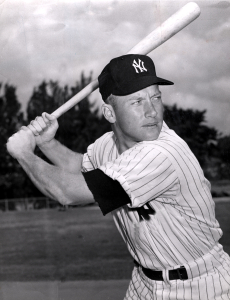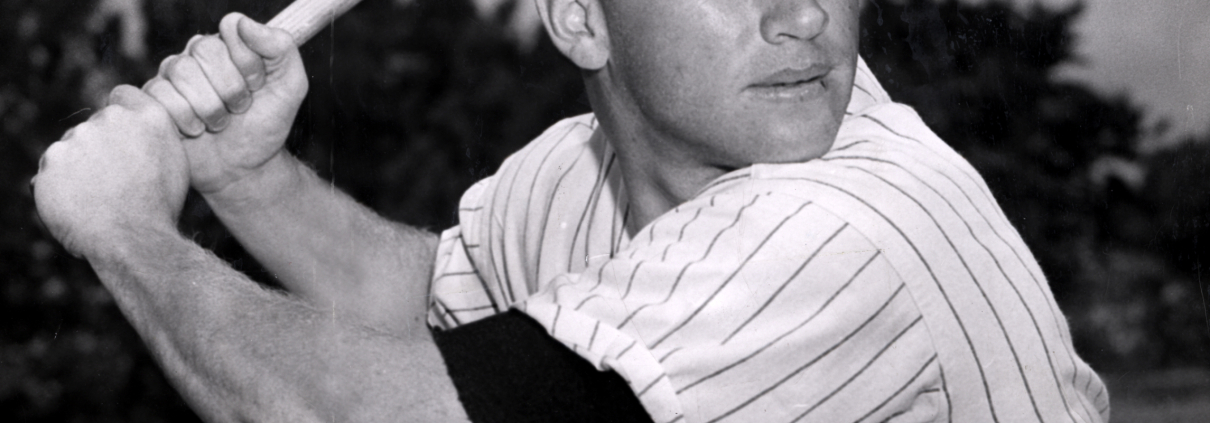May 13, 1955: Mantle slams 3 homers against Tigers, including first career switch-hitting pair
 Only 22 years old at the start of his fifth major-league season in 1955, Mickey Mantle was on a clear path to stardom. He had become the New Yankees’ new wonder-boy, providing a seamless transition from legendary Joe DiMaggio in center field. Since his second season in 1952, Mantle had battled right knee and left leg problems, requiring knee surgery at the end of 1953. Another surgery to remove a cyst on his knee in February 1954 caused him to miss nine games early in the season. Having recovered by the 1955 season, the switch-hitting Mantle raised his game another level. His three home-run clouts against the Detroit Tigers on May 13, including a rare occurrence of homers hit from both sides of the plate, were indicative of how much he would spur the team’s success.
Only 22 years old at the start of his fifth major-league season in 1955, Mickey Mantle was on a clear path to stardom. He had become the New Yankees’ new wonder-boy, providing a seamless transition from legendary Joe DiMaggio in center field. Since his second season in 1952, Mantle had battled right knee and left leg problems, requiring knee surgery at the end of 1953. Another surgery to remove a cyst on his knee in February 1954 caused him to miss nine games early in the season. Having recovered by the 1955 season, the switch-hitting Mantle raised his game another level. His three home-run clouts against the Detroit Tigers on May 13, including a rare occurrence of homers hit from both sides of the plate, were indicative of how much he would spur the team’s success.
The Yankees’ string of five straight American League pennants had been interrupted in 1954 by the Cleveland Indians, so they were anxious to return to their seemingly perennial position atop the league. However, the Indians and Chicago White Sox turned out to be formidable opponents, and the three teams held either the first, second, and third spots in the league for practically the entire season.
Coming into the contest on May 13, Casey Stengel’s Yankees and Bucky Harris’s Tigers were tied for third place, 3½ games behind the Indians. The Yankees were playing their third game of a scheduled 16-game homestand, having lost to the Indians in the first two games.
The Friday afternoon game was played before only 7,177 spectators. The Yankees’ Whitey Ford and the Tigers’ Steve Gromek started the game as mound opponents.
Batting left-handed, the muscular Mantle began his home-run onslaught in the first inning. After Andy Carey got on base with a bunt single, Mantle hit a line drive that cleared the bleacher wall above the auxiliary scoreboard near the Yankees bullpen. It was the first of three massive blasts that the New York Times reported “end to end would have measured in the neighborhood of 1,300 feet.”1
Ford was efficient in this first three innings, yielding only a walk that was erased by a double play.
In the third inning, Mantle was again involved in the scoring. Hank Bauer singled and advanced to second on Carey’s sacrifice. Mantle’s single scored Bauer for the Yankees’ third run.
Ford was aided by another double play in the fourth inning and didn’t give up his first hit until Ray Boone singled in the fifth inning.
In the bottom of the fifth inning, Mantle got the best of Gromek again with a towering home run into the seats by the 407-foot sign in right-center field. With no one on base, the Yankees lead went to 4-0.
Ford retired the side in order in the sixth, and then gave up the Tigers’ only runs the next inning on Boone’s two-run homer. Ford left the game after the seventh because of a blister on his middle finger.
Leading off the bottom of the eighth, Mantle batted right-handed against lefty relief pitcher Bob Miller and smashed his longest home run of the day for a 5-2 final score. It followed the same course as his first home run, except it was higher and farther. In the process, he became the first Yankee and only the fourth American League player to homer from both sides of the plate in a game. The New York Times speculated that Mantle was the first in American League history, a belief that was later promulgated in numerous publications. In fact, Philadelphia’s Wally Schang was the first in either league to accomplish the feat, on September 8, 1916.2 It was Mantle’s only three-homer game.
The Sporting News reported that Mantle said he had used two borrowed bats in his homer spree. One had been discarded by Enos Slaughter when he was sold to Kansas City earlier in the week. The other bat was borrowed from teammate Bill Skowron.3
Mantle went on to homer from both sides in a game 10 times during his 18-year career. Mark Teixeira and Nick Swisher are tied for the record for most occurrences (14), while Carlos Beltran (12) is also ahead of Mantle. Mantle became the model for modern power-hitting switch-hitters. He hit 536 career home runs and is followed by prolific switch-hitters Eddie Murray (504), Chipper Jones (468), Beltran (435), and Teixeira (409).
In picking up his fourth win of the season, Ford gave up three hits and two walks while striking out three in seven innings. He wound up tied for the American League lead in victories (18). Tom Morgan, who had emerged as a reliable Yankees reliever, finished the game with two hitless innings. Gromek took only his second loss of the season against five victories. Boone collected 20 homers for the season and with 116 RBIs tied with Jackie Jensen for the lead in the American League.
The Yankees proceeded to win 12 of the 16 home games to take first place by 2½ games over Cleveland by May 26. They were led during that stretch by Mantle’s hitting, which included a slash line of .462/.592/1.000, 14 extra-base hits among his total of 24, and 19 RBIs.
Mantle had changed his batting stance at the start of the 1955 season, to cut down on his strikeouts, after leading the league with 107 in 1954. His new approach was to crowd the plate more and be more selective with pitches.4 His numbers by the end of May indicated that the change was working.
He finished the season leading the league in on-base percentage, slugging average, OPS, triples (tied with Andy Carey), home runs, and walks. His accomplishments that season set the stage for one of the best single-season batting performances the following year, when he won the Triple Crown and the MVP Award.
The Yankees recaptured the American League pennant in 1955, capitalizing on an eight-game winning streak between September 13 and 21. After securing first place by two percentage points on September 16, they never relinquished the lead, finishing three games ahead of the Indians and five games ahead of the White Sox.
The Yankees lost the World Series in seven games to the Brooklyn Dodgers, who finally achieved a championship after losing five in as many attempts against the Yankees, dating back to 1941. The Dodgers got a huge break in the ’55 Series when Mantle was limited to 10 plate appearances in three games because of a leg injury.
Mantle continued with the Yankees until his retirement in 1968, although his performance declined significantly after the 1964 season. Various injuries curtailed his playing time, but he remained one of the most popular players in the game. The three-time MVP was elected to the Baseball Hall of Fame in his first year of eligibility, 1974, with one of his many hallmarks being his prodigious switch-hitting.
Sources
In addition to the sources cited in the Notes, the author consulted:
Middlesworth, Hal. “Mantle Puts Slug on Tigers, 5-2,” Detroit Free Press, May 14, 1955: 13.
Leavy, Jane. The Last Boy: Mickey Mantle and the End of America’s Childhood. (New York: HarperCollins, 2010).
Photo credit: National Baseball Hall of Fame Library.
Notes
1 Joseph Sheehan, “Yanks Best Tigers on Mantle’s 3 Homers,” New York Times, May 14, 1955: 14.
2 Baseball Almanac, baseball-almanac.com/feats/feats20.shtml. (Accessed May 5, 2020).
3 “Mantle Borrows, Two Bats and Belts Three Homers,” The Sporting News, May 25, 1955: 21.
4 Al Silverman, Mickey Mantle: Mister Yankee (New York: G.P. Putnam’s Sons, 1963), 131.
Additional Stats
New York Yankees 5
Detroit Tigers 3
Yankee Stadium
New York, NY
Box Score + PBP:
Corrections? Additions?
If you can help us improve this game story, contact us.


